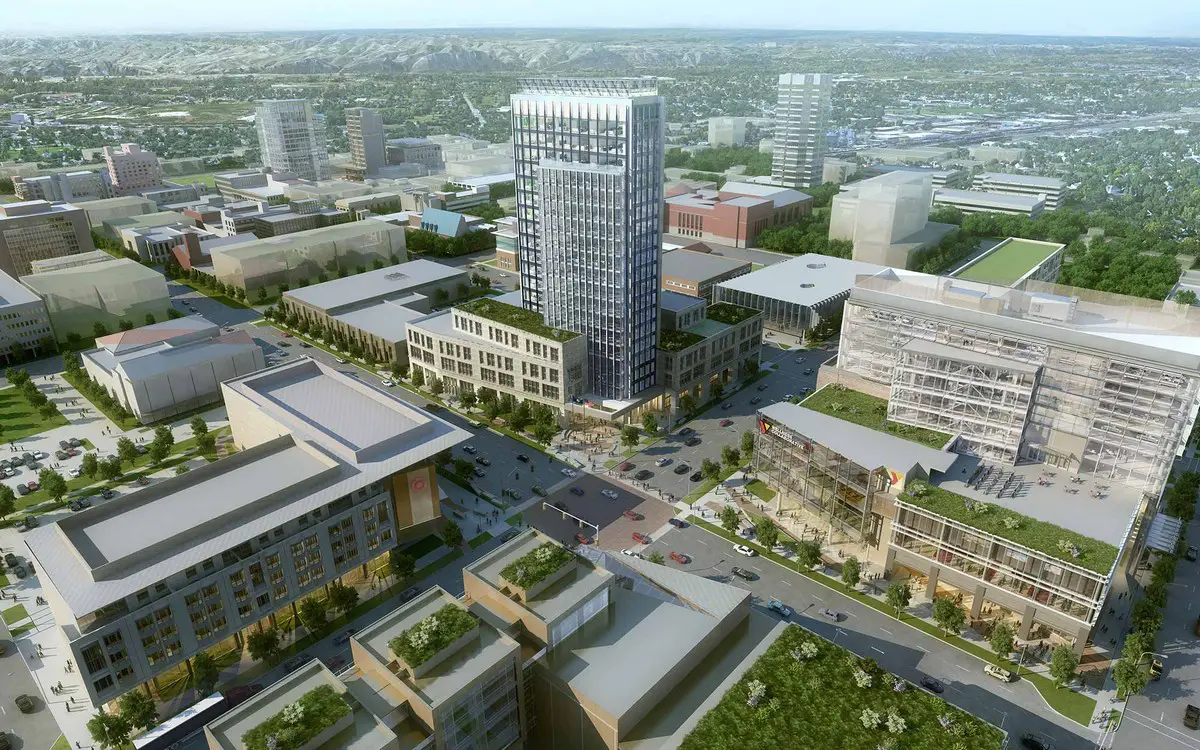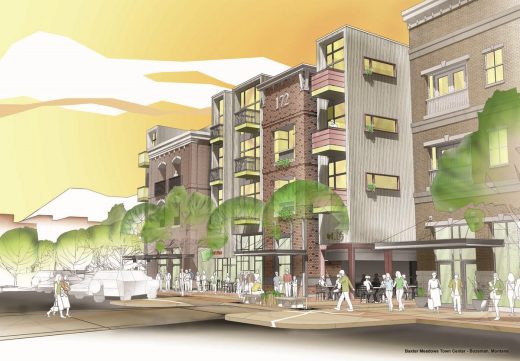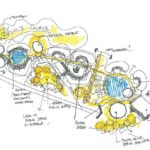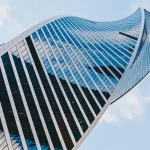Reduce, re-use, re-imagine, Work environments advice, Compact neighborhood design, Architecture
Reduce, re-use, re-imagine
August 17, 2021
By Keith Walzak, AICP, ASLA, Director of Landscape Architecture and Urban Planning at Cushing Terrell
Reduce, re-use, re-imagine: How to slow climate change by slowing urban sprawl
By Keith Walzak, Director of Landscape Architecture and Urban Planning at Cushing Terrell
The case for compact, vertical, walkable urban neighborhoods
Reduce, re-use, re-imagine – slow urban sprawl
In the U.S., we’ve typically defined upward mobility as outward growth: larger properties, bigger homes, more cars. But as we’ve stretched out and claimed more for ourselves, it’s come at the cost of the environment and a comfortable future.
Last month, the Intergovernmental Panel on Climate Change (IPCC) released its latest report on the state of the warming planet, stating: “It is unequivocal that human influence has warmed the atmosphere, ocean, and land.” Findings from the report — approved by 195 governments and based on more than 14,000 studies — also showed that aggressive, rapid, and widespread cuts to greenhouse gas (GHG) emissions, if they begin immediately, could limit warming beyond 2050.
Yet, when we think of cutting emissions, a sparkling new subdivision or a stop at the supermarket on the commute home from the office may not come to mind. We’re more likely to envision congested freeways, overpopulated cities, heavy resource extraction, and industrial smokestacks. However, accommodating urban sprawl — necessitating new buildings, more driving, and larger parking lots — is a major contributor of GHG emissions.
What we likely default to considering is how the changing climate affects where and how we live, work, and play — not the other way around. We focus on how a flood could knock out power to the supermarket or how a fire could damage our home. But the reality is, the ways in which we develop and use land play a big role in how these places are impacted.
Building Performance – Bodega Boise Retail by Cushing-Terrell:
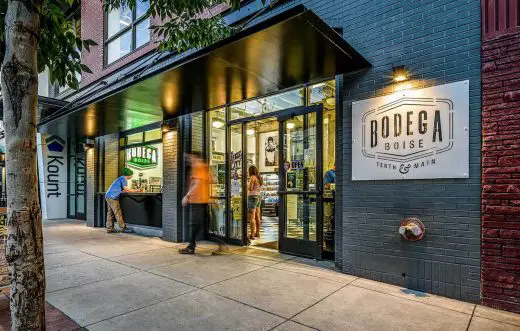
Reversing the Trend
While the IPCC report didn’t detail techniques for reducing GHG emissions and halting global warming (that report is expected in 2022), another paper published in the spring specifically explored the possibility of turning the tide of climate change by way of sustainable land use. The authors of the report, published by the Brookings Institution, detail how decades of sprawl have made the U.S. a world leader in both building-related energy consumption and vehicle miles traveled per capita. Additionally, they found that lower-density development can pollute water sources and result in higher relative emissions during initial construction.
The trend toward urban sprawl is largely driven by people’s preferences for low-density residential areas. Contributing factors include the benefits of newer homes and subsequent home value (driven by average cost per square foot and amenities provided in larger suburban homes), nearby shopping, better schools, and greater security (whether real or perceived). Pro-sprawl policies that favor road infrastructure and discourage vertical development also have contributed to the outward growth.
That’s not to say, however, that we have no pull in reversing the trend toward sprawl and reducing GHG emissions. In fact, designers, architects, and builders have made large strides in recent years in terms of greening buildings. Now, we need to go deeper than all-electric homes, solar panels, and recycled materials; we need to focus on why, where, and how to build in general. This means rethinking the entire planning, design, and construction process as well as changing local development regulations and policies that currently promote urban sprawl development patterns.
Greyhound-Mixed-Use – conceptual design by Cushing-Terrell:
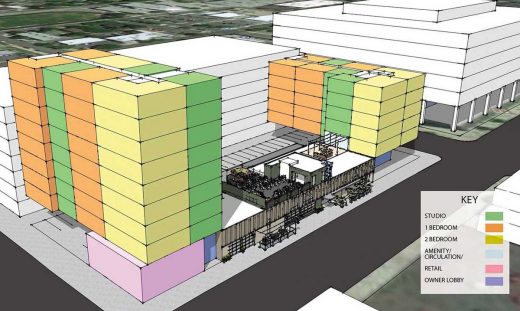
What can be done now to make positive change for future generations?
1) Land-use planning: Cities, counties, and communities can focus on changing land-use planning strategies and guide growth and development toward compact, vertical, walkable neighborhoods and districts. Communities can rethink annexation policies to control how growth is defined, spurring enclaves or cluster developments that preserve and encourage open spaces and agricultural lands that help eliminate food deserts.
2) Education: The design, planning, and development community can help educate people about how such changes will make a difference and provide benefits, and we can demonstrate the logistics of how to design and build in denser environments. We can show how regenerative and resilient design that encourages human-centered solutions is not only doable, but imperative.
3) Partnerships: In addition to simply understanding that urban sprawl is problematic for the environment, we need to dig into how and why. This is where a variety of experiences and expertise comes into play. Not only can design firms tap into the variety of resources they may have in-house, but also partner with city leaders, developers, and financing institutions. What might a nonprofit or government entity know about a region that would propel the reimagining of an unused warehouse or vacant lot? What does a specific area need to make it more conducive to walking? Where might a community garden make a place more livable? Partnerships are key to understanding land use needs and solutions, as well as helping to drive policies that encourage more climate-friendly development.
4) Walking the walk: As we aim to design and build more sustainably, there will be choices we have to make related to both money and morals. Design firms will have to be clear on their mission: What is it that we truly believe in? Because the conversation about urban sprawl and climate change also includes discussions about equity and social justice. When we decide to tackle any of these subjects, what does it mean, exactly, and does our work align with our values? And of course, there’s the monetary investment — putting our money where our morals are.
Keith-Walzak, Cushing-Terrell:

Understanding the Problem of Urban Sprawl
While the thought of pollution may bring densely packed urban cores to mind, research suggests (from coolclimate.org) these areas have lower levels per capita of GHG emissions and other pollutants, compared to their less-dense neighbors. The key difference being that in older urban locales, the living spaces and city blocks tend to be smaller, promoting cleaner modes of movement such as walking and biking. The climate-related problems caused by urban sprawl come down to two main factors: new builds and the transportation they necessitate.
Although design firms have pioneered and adopted ways to make buildings greener, development in car-dependent areas often incentivizes less energy-efficient design. As the Brookings team explains, these regions typically include detached buildings that miss out on the energy efficiencies of shared walls and walkways. Single-family homes with more square footage also require more energy for climate control and other utilities. Even constructing these low-density neighborhoods requires more physical capital per person, which translates into more building materials and emissions to manufacture the necessary concrete, asphalt, piping, and other inputs — and all such materials can radiate heat back into the atmosphere to cause higher temperatures.
On the non-residential end, commercial and industrial buildings with large footprints and low heights — think of office parks and shopping centers — also can require more energy to heat and cool because of inefficient structural design.
Perhaps an even greater issue than the buildings themselves is what those new builds necessitate: More urban sprawl means more driving and higher GHG emissions. According to the Environmental Protection Agency, transportation makes up the largest portion (29%) of GHG emissions in the U.S. as of 2019. And in 2018, a report from the California Air Resources Board found that increased driving was hurting the state’s ability to meet its climate goals, thus the board called for denser development as one solution.
Star Market Boston, MA, USA, by Cushing-Terrell:
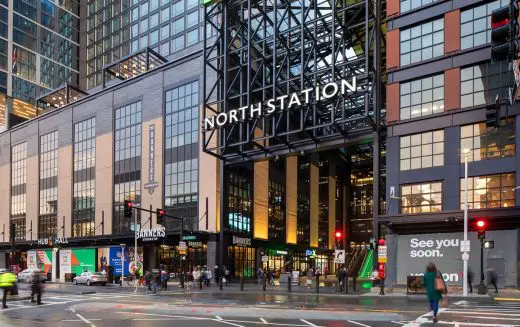
There are still plenty of people who will argue for the individual benefits of living in less-dense regions, such as lower noise or light pollution, but there’s also research that negates many of the misconceptions of living in dense urban areas. One recent study found that large U.S. cities have lower rates of depression because of the number and variety of human social networks available to them — running counter to the popular belief that these regions can feel cold and isolating. It’s just one more reason that stopping sprawl can be good for both people and the planet.
Solutions Through Human-Centered Development
Battling climate change through design, while having obvious implications for land use, is about centering development on the users. Designing for people’s well-being tends to result in more conscious, sustainable design. Similarly, if you solve for a warming planet, you make the world more livable for its inhabitants. To realize better places for people, as well as reduce our impact on the earth, there must be a focus on 1) high-performance buildings, 2) mobility, and 3) compact communities.
Work has progressed (and continues to progress) on the first aspect, designing and building high-performance buildings. Look no further than the influx of LEED (Leadership in Energy and Environmental Design), Green Globes, WELL, and other certifications as proof — not to mention the strong push from businesses, cities, and developers to realize energy-efficient, resilient buildings that result in cost-savings.
The second two aspects, mobility and compact communities, are beginning to receive far more attention, and they specifically focus on resisting sprawl and embracing smaller footprints. Higher mobility means an increased use of lower GHG-emitting forms of transportation, such as public transit, biking, and walking. And compact communities require less transportation in general when workplaces, entertainment, and shops are all in close proximity.
One Big Sky District – Landscape Architecture Planning, USA, by Cushing-Terrell:
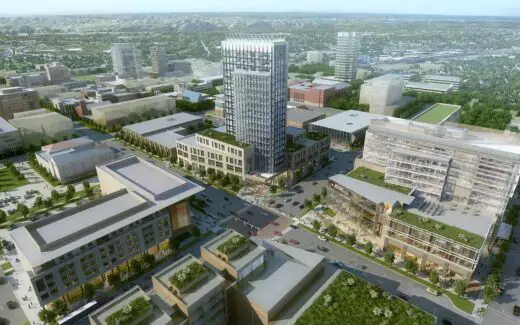
Sustainability in Reimagining What Already Exists
Reimagining design in dense regions includes reimagining our existing spaces. Rather than constructing a new building, we can think about reusing existing structures. This strategy is tied to the concept of a circular economy, one that feeds and sustains itself rather than seeking out new sources of energy, materials, or land once the old ones have been depleted. Reusing existing structures also can reduce embodied carbon. This is the carbon footprint of a building or infrastructure project unrelated to its operation and including the carbon dioxide produced to build, maintain, and eventually demolish it and dispose of the waste materials.
While “starting from scratch” may feel like the easier option, solutions such as adaptive reuse can have enormous economic upsides. Land assemblage and new, walkable infill dedicated to a mix of uses and located near public transit is another plausible strategy. A study from the Preservation Green Lab of the National Trust for Historic Preservation found historic rehabilitation over a 32-year period created two million jobs and generated $90 billion in private investment. The research also found that residential rehabilitation creates 50% more jobs than new construction.
Adaptive reuse is good for regional economics as well. Revitalizing urban areas can draw more residents and visitors, thus increasing the value of nearby properties and boosting local tax revenues. The benefits to cities are so high that some are starting to incentivize the reuse of old properties, such as increased density allowances and flexible approval and permitting processes — all of which can save investors time and money.
Making communities and neighborhoods more walkable can result in more room for green space with health benefits for both humans and the earth. Adding more trees that provide shade mitigates the urban heat island effect, wherein dense concentrations of pavement, buildings, and other surfaces absorb and retain heat. Reducing the amount of paved surfaces also discourages the use of vehicles and can help make areas less prone to flooding.
We can look to concepts like the 15-minute neighborhood, where residents can easily access day-to-day needs such as food, education, and outdoor space within a 15-minute walk from home. This may require streets that allow safe mobility for all types of transportation and taking into consideration the Fitwel standard, which scores on design and operational strategies for buildings based on health behaviors and risks. These and other strategies and programs help elevate the discourse on pedestrian-first environments, which reduce barriers to create comfortable, safe places for all age groups and abilities.
With the reduction of sprawl also comes the protection of natural environments. Certain natural landscapes actually serve as carbon sinks, defined as areas that absorb more carbon from the atmosphere than they release. Protecting these environments from development and sprawl not only stops further climate change, but also helps repair the damage we’ve already done.
Moving Forward
At this stage in battling climate change, the world has a clear understanding of how we got here, how bad the problem is, and how much worse it will be if we continue our current trajectory. What’s less obvious are the specific steps each sector needs to take to reduce GHG emissions.
Our ambition is to explore some of the areas we touch in our industry that could make an enormous difference, particularly as it relates to urban sprawl. Our experts are constantly engaging with the world around them and questioning how the work gets done. We plan to examine how reimagining urban spaces affects equity, the benefits of reusing existing buildings and spaces, and how we can maintain the concept of placemaking and character as we reimagine cities.
We hope this opens up a larger conversation not only within our firm, but with our clients and the industry at large, allowing us all to be part of the solution.
About Keith Walzak, AICP, ASLA
Keith is the director of landscape architecture and urban planning at Cushing Terrell. Inspired by people and places, he is committed to improving the health and livability of communities. Keith specializes in sustainable community design, urban planning policy, community engagement, capital improvement programming, and project management with emphasis in sustainable urbanism, downtown and mixed use districts, transit-oriented development, multi-modal access, civic park and cultural arts strategies.
Comments on this guide to Reduce, re-use, re-imagine article are welcome.
Building Design
Property Articles
Design: sculpture by Gerry Judah
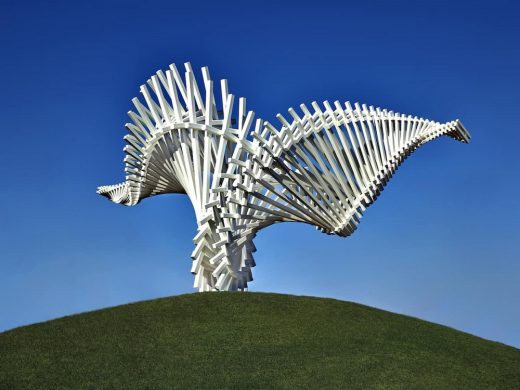
photo : Dan Sellers
DRIFT, Dallas, Texas sculpture by Gerry Judah
Design Architect: Schmidt Hammer Lassen Architects
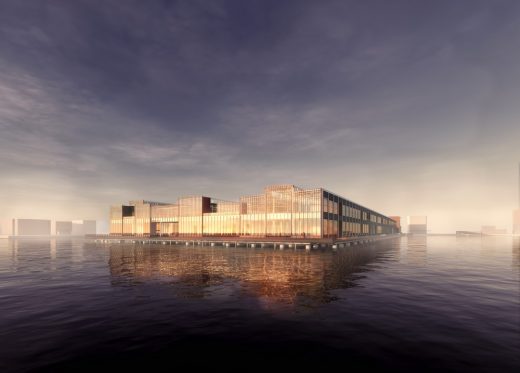
image © Schmidt Hammer Lassen Architects
Commonwealth Pier Boston
Sustainable Architecture Design
Comments / photos for the Reduce, re-use, re-imagine advice – post by Cushing Terrell page welcome

